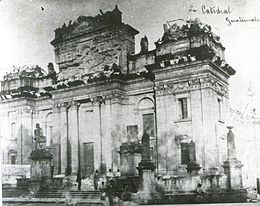1917 Guatemala earthquake

Guatemala City Cathedral after the earthquakes
|
|
| Date | November 1917 to January 1918 |
|---|---|
| Magnitude | 5.6 (25 December 1917) |
| Depth | 5 km (3.1 mi) |
| Epicenter | 15°19′N 89°06′W / 15.32°N 89.1°WCoordinates: 15°19′N 89°06′W / 15.32°N 89.1°W |
| Areas affected | Guatemala |
| Aftershocks | Several |
| Casualties | 250 dead |
The 1917 Guatemala earthquake was a sequence of tremors that lasted from 17 November 1917 through 24 January 1918. They gradually increased in intensity until they almost completely destroyed Guatemala City and severely damaged the ruins in Antigua Guatemala that had survived the 1773 Guatemala earthquakes.
The seismic activity started on 17 November 1917 and ruined several settlements around Amatitlán. On 25 and 29 December of the same year, and on 3 and 24 January of the next, there were stronger earthquakes felt on the rest of the country, which destroyed a number of buildings and homes in both Guatemala City and Antigua Guatemala. Sometimes the movement was up and down, then sideways. At every new shock a handful of houses went down. In most of the houses, walls cracked in two and then roofs fell in; in churches, bell towers crashed down, burying adjacent buildings and their occupants.
Among those buildings destroyed by the earthquakes were a lot of the infrastructure built by general José María Reyna Barrios and president Manuel Estrada Cabrera, whose legacy has been forgotten by Guatemalans. The Diario de Centro América, a semi-official newspaper owned in part by President Estrada Cabrera, spent more than two months issuing two numbers a day reporting on the damage, but after a while, started criticizing the central government after the slow and inefficient recovery efforts.
One of its articles said that some holy Jesus images from the city had been saved because they had been taken away from their churches after the first earthquake as they "did not want to stay anymore in a city where excessive luxury, impunity and terror were rampant". Likewise, the newspaper reported that the National Assembly was issuing "excellent" laws, but nobody was "going by the law". Finally, on its front page of May 1918, it said that there was "still debris all over the city". The Diario de Centro América itself was print in the rubble, in spite of which it was able to issue its two daily numbers.
The French magazine L'Illustration on its 12 January 1918 issue reported on a telegraph cable from 31 December 1917 that Guatemala city had been completely destroyed: two hundred thousand people were left homeless and there were about two thousand deaths. The city's monuments were lost. In 1920, Prince Wilhelm of Sweden arrived to Guatemala on a trip along Central America; his journey took him to Antigua Guatemala and Guatemala City where he saw that the recovery efforts were still not done and the city still lay in ruins. There was still dust whirling in thick clouds, penetrating everywhere – clothes, mouth and nostrils, eyes and skin pores – visitors got sick until they got used to the dust; the streets were not paved and only one in three houses was occupied, as the others were still in ruins.
...
Wikipedia

